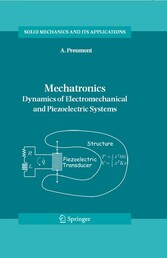Search and Find
Service
3 Electromechanical systems (p. 61-62)
3.1 Introduction
The two preceding chapters have addressed separately the dynamics of mechanical systems and the dynamics of the electrical network. In this chapter, we consider the dynamics of composite systems formed by in- terconnecting mechanical and electrical variables.
The central element in this interconnection is the conversion of mechanical energy into electri- cal energy, and vice versa, which takes place in electromechanical transducers. Electromechanical transducers are pervasive in modern life, they include microphones, loudspeakers, electrical motors, magnetic suspen- sions, capacitive accelerometers, and also microelectromechanical systems (MEMS).
Piezoelectric transducers will be treated in a separate chapter. This chapter starts with a review of the constitutive equations of the most frequent lossless lumped parameter electromechanical transducers. It is followed by the statement of Hamilton’s principle for electromechan- ical systems, the Lagrange equations, and a set of examples where the dynamic equations governing a few classical electromechanical systems are established.
3.2 Constitutive relations for transducers
A conservative transducer is a transducer which conserves energy, it is also called lossless. There are two types of transducers, those which can store energy and those which can only transfer energy from one form to the other, without being able to store it. In a transducer which can store energy, the energy can be stored in one form (either mechanically or elec- trically) and recovered at a later time in another form.
On the contrary, a transfer element transforms one form of energy into the other form, but the instantaneous power at the input is always equal to the instanta- neous power at the output. The theory of lumped parameter transducers is based on the quasi-static theory of electromagnetism, which assumes that the physical dimension of the device, l, is much smaller than the electromagnetic wavelength (l/? « 1). Under this assumption, the field that produces forces in the transducer is either electrical or magnetic, but not both, this allows us to separate the analysis of electrical forces in capacitive transducers, and magnetic forces in inductive transducers.
3.2.1 Movable-plate capacitor
A movable plate capacitor is a conservative energy storing transducer which allows electrical energy to be transformed into mechanical energy and vice versa. The charge on the capacitor is q and the voltage across the plates is e, the displacement of the movable plate is x and the external force required to hold the movable plate in equilibrium against the electrostatic attraction force is f. The electromechanical transducer is assumed to be perfect, meaning that the electrical side is a pure capac itance, and the mechanical construction is massless and without sti®ness or damping.
All prices incl. VAT












